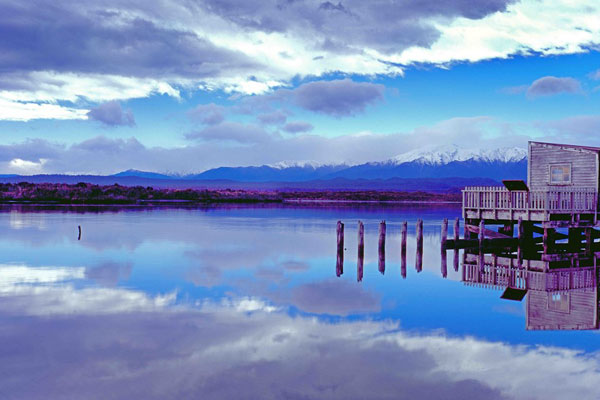
New Zealand is set to increase its total mainland marine conservation domain by 50 per cent with the planned establishment of five new marine reserves.
The five reserves, formally approved by NZ Conservation Minister Dr Nick Smith, cover 17,500 hectares and feature spectacular, unique coastlines and marine habitats.
They are all on the South Island’s West Coast and will add to the already significantly protected region, which includes three national parks and a World Heritage Area.
The minister’s approval means that the process of establishing the reserves goes into the final stages of obtaining approval from two other government departments.
Mainland marine reserves
Establishment of the new reserves was a major step forward for marine conservation, Dr Smith said, as it increased the number of mainland marine reserves from 30 to 35, boosting the area protected from 33,574 to 51,102 hectares.
“We are a nation with some of the most spectacular and unique coastlines in the world and we need to recognise the importance and value of not only our special places on land, but our marine habitats as well,” he said.
The reserves – at Kahurangi, Punakaiki, Okarito, Tauparikaka and Hautai – would enhance understanding of the region’s unique marine habitats and complement the adjoining protected areas of national parks and the Te Wahipounamu South West New Zealand World Heritage Area.
Kahurangi Marine Reserve
Kahurangi Marine Reserve includes examples of northern West Coast marine habitats and ecosystems over a range of depths.
There is a rich diversity of fish and invertebrate species, partly due to the abundant reef habitat and the influence of more northern species. The area is important for marine mammals.
The new marine reserve adjoins Kahurangi National Park and includes the catchment area and mouth of the Heaphy River, and Kahurangi-Oparara coastline which is notable for its sand dunes and beach vegetation.
Punakaiki Marine Reserve
Punakaiki Marine Reserve – occupying a dramatic coastline that includes the internationally significant Pancake Rocks and blowholes at Dolomite Point – harbours a variety of northern West Coast marine habitats and ecosystems.
The rocky shore biological communities are typical of the northern West Coast, but their overall extent, diversity, and accessibility is notable relative to many other parts of the same area.
It is adjacent to the coastal habitats and ecosystems of Paparoa National Park and closed whitebaiting areas in Bullock Creek and tributaries of the Punakaiki River.
Waiau Glacier Coast Marine Reserve
Waiau Glacier Coast Marine Reserve includes a number of central West Coast marine habitats.
The area is a good example of central Westland coastal landscapes that are dominated by past and present glaciations, and it supports fish, invertebrates and seaweeds that are typical of the middle latitudes of the West Coast.
It is close to the internationally renowned Ōkārito Lagoon and other natural estuaries that are important spawning and nursery habitat for native fish such as giant kokopu and inanga. The reserve adjoins the Ōkārito Mataitai Reserve and some largely unmodified coastal lands within Westland Tai Poutini National Park and Te Wāhipounamu South West New Zealand World Heritage Area.
Tauparikaka Marine Reserve
Tauparikaka Marine Reserve is a good example of natural beach and tidal lagoon habitats.
The area is notable for coastal dunes that have a high biodiversity value. There are wetland, sand dune, and lowland forest habitats nearby and Ship Creek / Tauparikaka flows through public conservation land from a natural forested catchment that is part of Te Wāhipounamu South West New Zealand World Heritage Area.
The sea portion is part of an area known for an unusually high presence of Hector’s dolphins, and adjoins the Tauparikaka Mataitai Reserve.
Hautai Marine Reserve
Hautai Marine Reserve includes representative examples of a variety of southern latitude West Coast marine habitats lying on the inshore margins of a complex submarine landscape of canyons and rocky reefs.
This section of coast has habitats of high wildlife value, including marine mammals and seabirds. It adjoins a large expanse of protected conservation land within Te Wāhipounamu South West New Zealand World Heritage Area.
Establishment process
The Department of Conservation publicly notified the new reserves last year after they were unanimously recommended by the West Coast Marine Forum – representing the resident Ngāi Tahu Maori tribe, commercial and recreational fishers, conservationists, tourism operators and local councils.
Many people contributed to the lengthy consultation process which included 159 submissions of which all but four were in favour.
The NZ Marine Reserves Act requires the Minister of Conservation, after considering the submissions, to decide whether to uphold any of the objections, or to proceed.
The decision to proceed means the process now goes to the final stage of seeking the concurrence of the Ministers of Primary Industries and Transport to enable the reserves to be surveyed and gazetted later this year.
New Zealand currently has 34 marine reserves, protecting around 13,000 square kilometres. This is 6.9% of New Zealand’s Territorial Sea and about 0.3% of New Zealand’s Exclusive Economic Zone.




Leave a Reply